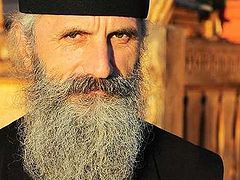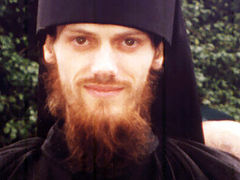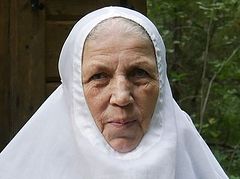Abbess Elikonida (Lysenko) of St. John’s Convent in the village of Alexeyeva (Saratov Province) speaks about the “non-coincidental” coincidences through which the all-powerful providence of God manifests itself in human destinies.
Calling grace
My generation came to God in the late 1980s-early 1990s. In 1988, the jubilee year of the millennium of the Baptism of Rus’, the state finally turned to the Church, persecuted by it for many decades, and began to return the monasteries that had been seized during the time of godlessness.
Then began the revival of Optina Monastery—the ancient monastery of the venerable Optina elders, comforters, and spiritual luminaries of Russia. The calling grace of this monastery rising from oblivion and desecration was so strong that people who came there, even in passing, sometimes for the sake of simple curiosity, could no longer live as before—without God.
An “accidental” trip to Optina Monastery
I wound up in Optina seemingly by accident, but actually providentially: The Lord speaks with us through such accidents and life circumstances.
My friend went to Kozelsk, to the metal works factory, on a business trip. She invited me to join her, explaining that we could visit Optina Monastery. So we, young girls, went to an unfamiliar town. Optina lay in ruins. This was 1989.
The dean at the time, Fr. Melchizedek (Artyukhin) (now Archimandrite), blessed us to eat at the trapeza after the service, gave us an obedience, and showed us where to settle in for the night. We carried bricks and slept in the guesthouse next to the monastery. It wasn’t a guesthouse yet at that point—it was just a half-ruined building. We slept on whatever we could: some old mattresses, piles of clothes. I was luckier than others: I had a cot. But when I nestled into it, extremely tired, it turned out it was broken and even the slightest movement threatened to overturn it.
Right in the middle of our cell stood a large steel trough—water dripped into it all night from the ceiling. The trough made a serious rumble, and to this rumble we sweetly slept, exhausted from the trip and the bricks.
What was there to like about Optina then? The disorder, the ruin, the overgrown nettles? Now I understand that we were feeling the grace and prayer of the monastery, but at that time it was completely incomprehensible. We knew only one thing: A new, extraordinary, and very attractive world had miraculously opened before us.
When we were returning, my friend said thoughtfully: “How alluring it is!”
A stranger wouldn’t have understood what she meant, but I understand her well. I had never before experienced such feelings as in Optina, as if my soul had finally found what it had long been searching for.
My friend is now the abbess of the St. Alexei Monastery in Saratov, Mother Theodosia (Bessonova).
First experience of prayer
Here I should note that I, like many of my peers, grew up in an unbelieving family: Atheism was planted in us in school and in college.
My father is a soldier. I was born in the Far East and have crisscrossed half the country with my parents. My grandparents lived far away and I never heard about the faith. The first time in my life that I turned to God in prayer was completely unexpected for me. I had to take some exams, with a huge number of questions, and I suddenly prayed: “Lord, if You exist, help me to pass my exams!”
And I had the feeling that I was heard, that my prayer was answered. I passed everything with the highest grades.
Then my father was transferred to serve in Kaluga.
“As if it weren’t late already!”
My friend and I started going to Optina, working at obediences, cleaning up in the churches with extraordinary joy, and praying at the services. I also had an obedience in the guest house, where I met many pilgrims. They revealed to me their destinies and the way Divine Providence worked in their lives.
The rebirth of Optina Monastery, the center of spiritual life in Russia, brought many young people here desiring to zealously serve the Lord. The brothers remained here to labor, and the female pilgrims, wishing to save themselves in the monastic rank, were most often blessed to go to the convents that were also revived after many years of ruin.
 The monastery bell tower during the years of restoration
The monastery bell tower during the years of restoration
Thus, in 1992, in Maloyaroslavets, in the St. Nicholas-Chernoostrovsky Monastery, its future abbess, Mother Nikolaya (Ilina), appeared. She fervently prayed to St. Ambrose of Optina to send her sisters, at least five people, and the saint answered her prayers: Thirty young women arrived to Maloyaroslavets from Optina, almost simultaneously.
My friend and I would also go to this monastery. I confessed there for the first time in my life. It wasn’t easy for me: I didn’t yet understand that we repent before the Lord, while the priest is a witness to our repentance. And I kept procrastinating my first confession.
I remember how one of the fathers said to me: “You need to confess!”
And I replied: “Sometime later…”
And he sternly noted: “As if it weren’t late already!”
Then I felt that my fears before confession were false.
My first confession
One time, on another trip to Maloyaroslavets, where my friend was working on obedience during her vacation, she advised me: “Write down your sins and go to confession.”
Fear again seized me. Perhaps for those who have lived a Church life for many years this fear is incomprehensible, but for newcomers, there are various temptations, including this kind. I stood waiting for confession and saw how the sisters were reading their prayer rule. None of them were paying any special attention to me, but for some reason I felt their support.
I met those sisters many years later—some of them had already become the abbesses of monasteries, and they confessed to me: “We knew you were going to your first confession in your life and were fervently praying for you!”
I confessed, and when I left the priest, something wonderful happened: Memories came flooding back, and I began, as if in a kaleidoscope, to remember all my old sins that I had long forgotten and which I sometimes didn’t even consider to be sins. I later understood that that’s how the mystery of confession works and the purification of the soul takes place.
 St. Nicholas-Chernoostrovsky Monastery
St. Nicholas-Chernoostrovsky Monastery
An unusual cross
At one point I was facing a very difficult situation, and it seemed to me there was no way out of it. I was fervently praying alone in my room when suddenly it seemed to me that the flame of the candles split, and the silhouette of an elder with a cross on his chest visibly appeared. The cross was unusual, and I remember it well. My heart was warm, I felt comforted, and my situation soon resolved itself in a wondrous manner.
I later recognized the elder on an icon, and in Diveyevo, among St. Seraphim of Sarov’s things, I saw the same unusual cross. This wonderful elder wore this heavy copper cross, given to him together with an icon by his mother, his entire life.
 St. Seraphim of Sarov’s copper cross
St. Seraphim of Sarov’s copper cross
A “chance” meeting
They say a future monk or nun is “pushed out” of the world. That’s how it happened with me. After I felt the grace of Optina, I realized I neither wanted nor was able to live in the world anymore. But I didn’t know if it was God’s will, and I really wanted to talk with an elder.
One time when I went to Maloyaroslavets, the sisters were just then, by happy “coincidence,” getting ready to go to the Holy Trinity-St. Sergius Lavra to their spiritual father—the elder Schema-Archimandrite Mikhail (Balaev) (1924-2009).
Mother Nikolaya blessed me to go and took me with them. In the monastery, I venerated the relics of St. Sergius of Radonezh and prayed fervently, asking him to help me find my path in life.
Then we wanted to go see Fr. Mikhail, but he was sick and not able to receive us. I was upset, of course, that I wouldn’t get an answer to my question, but there was nothing I could do. We stopped by the bookstore and I was delayed, and I somehow felt that the sisters had already gotten on the bus and left without me. There was no way that could happen, but something got mixed up, and it did happen.
I was at a loss what to do, but suddenly I “accidentally” met my one acquaintance who was a spiritual child of Elder-Archimandrite Kirill (Pavlov) (1919-2017). She was on her way to see him and took me with her. The elder simply looked at me and immediately said that my path was monasticism, and then he blessed me to go to a monastery.
 Elder-Archimandrite Kirill (Pavlov)
Elder-Archimandrite Kirill (Pavlov)
“God and the soul—that’s a monk”
So I wound up in a monastery and received the riassophore and then stavrophore tonsures with the name Elikonida, in honor of the martyr Elikonida of Thessaloniki.
Perhaps my story will be interesting to your readers, as the portrait of someone from the first monastic call after many decades of persecution against the Orthodox Church. Now we, those young men and women who went to the ruined Optina Monastery in the late 1980s, are already over fifty. It is precisely the people of this calling who are the core of our monasteries now, some having become abbots and abbesses.
I could speak about the external side of my own monastic life in two words, but you can’t speak about any monastic’s inner life in two words—it’s a spiritual mystery, for as St. Theophan the Recluse says: “God and the soul—that’s a monk.”
I labored in St. Alexei Convent in Saratov with Abbess Theodosia (Bessonova) for several years. In 2008, a dependency of this monastery was opened in the village of Alexeyeva, and I was sent there on obedience.
St. John’s Convent
In 2013, the dependency was transformed into St. John’s Convent, and I was elevated to the rank of abbess. The monastery was consecrated in honor of the righteous St. John of Kronstadt (1829-1908), who visited our Alexeyeva village in 1894 during his trip along the Volga. To the indescribable joy of all the inhabitants of Alexeveya, the saint served in an old wooden church with an altar to St. Sergius of Radonezh, built in the village by the care of the parishioners in 1788.
The righteous St. John of Kronstadt never abandoned those who turned to him for help during his lifetime, and now he pours out a sea of miracles and mercy upon those who entreat his prayerful intercession in strengthening their families, in deliverance from sorrows, and in healings from spiritual and bodily infirmities.
Being in this monastery, consecrated by the very presence of this great saint, numerous pilgrims have the opportunity to pray, to venerate sacred objects, and to labor to the glory of God. The monastery has a pond with a font where adults are baptized. Come and visit us!
***
St. John’s Convent website: http://ioann-monastir.ru/
E-mail: ioann-monastir@yandex.ru
Telephone: 8-987-830-29-12
Address: 412761 Saratov Oblast, Khvalynsky Region, Alexeyeva, Chapaeva Ul. 2B (Саратовская Область, Хвалынский район, поселок Алексеевка, ул.Чапаева, д. 2 В)
Film about the monastery:
http://ioann-monastir.ru/%d0%b2%d0%b8%d0%b4%d0%b5%d0%be/










